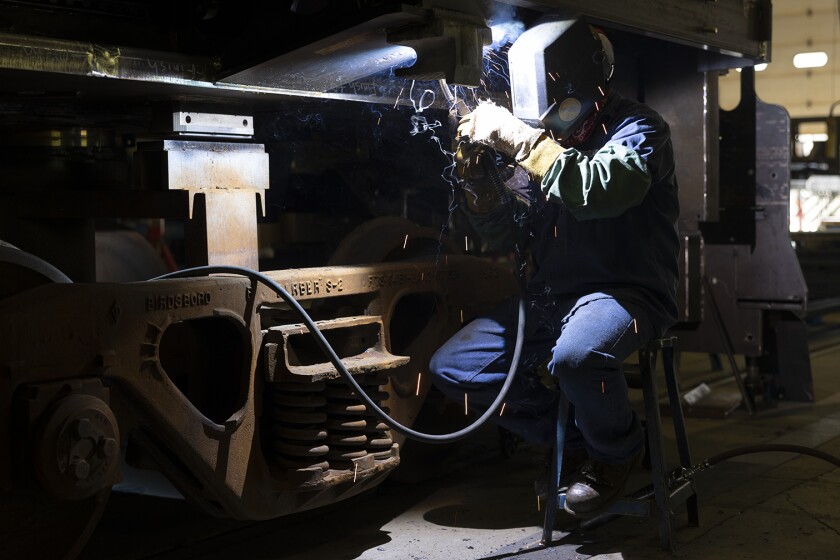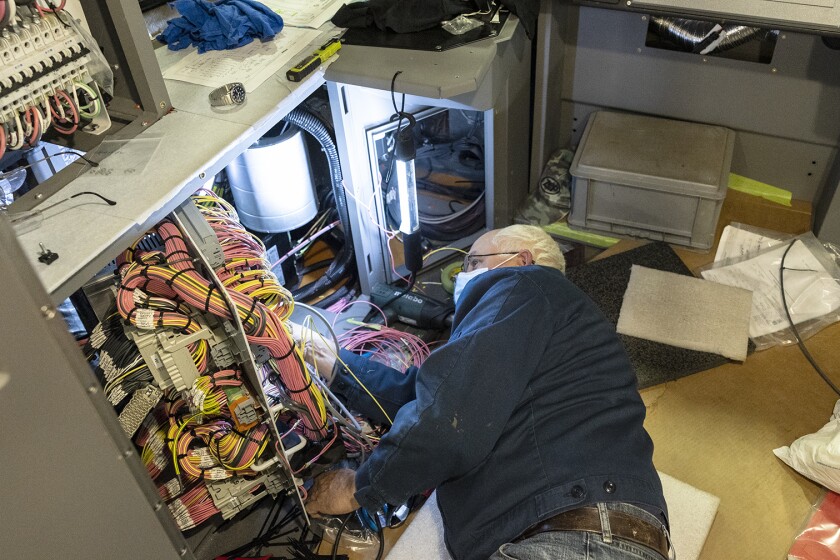The shiny green vehicle is one of six “Liberty NXT” streetcars, designed and built by the Brookville Equipment Corporation specifically for Tempe. The first was delivered in March, making the 2,000-mile trip by truck on a special flatbed trailer. Including the car undergoing testing today, the other five are still in the shop, in various stages of construction. Plans call for all six vehicles to be in Arizona before the end of the year, in time for the opening of Tempe’s new three-mile loop. Relatively new to the streetcar-building business, Brookville has supplied Liberty vehicles to Dallas, Detroit, Milwaukee and Oklahoma City. Two more cities, Tacoma, Wash., and Portland, Ore., are expecting their own Liberty cars in the next few years.
Building vehicles of its own design, the small American-owned company is competing against much larger international conglomerates in the streetcar market. Brookville’s vehicles meet “Buy America” requirements with over 70 percent of their parts sourced in the U.S., many from Pennsylvania. The success of the Liberty streetcar is mirrored in the increased availability of American-made parts.
“At first, we had to go with this [one] supplier because they’re the only ones that could meet Buy America,” says Brookville Vice President of Business Development Joel McNeil. “Now we’ve got five available to us. The supply just from Pennsylvania is amazing.”
Despite its history of giant steelmakers and railroad conglomerates, Pennsylvania has a tradition of small industry. Before the advent of canals, roads and rail, isolated farmers had to depend on locally produced goods, resulting in an unusually large number of companies. By 1860, Massachusetts and Pennsylvania were roughly even in industrial employment and production. But Pennsylvania was home to three times the number of manufacturing concerns.
A Streetcar Legend Is Born

(Photo Courtesy Brookville Equipment Corporation)
Several times over the next 100 years, the company changed names and owners, but never lost its focus on building machines that ride on rails. By the end of the 20th century, Brookville had settled into a new and much larger facility while expanding its mining vehicle business to include remanufacturing and modernizing both freight and passenger locomotives. Experience gained from these operations led directly to the company’s foray into engineering and manufacturing their own versions, including a fleet of 12 commuter locomotives for the South Florida Regional Transportation Authority in 2011.
As home-grown innovations in electronics and battery systems propelled the company forward, Brookville was also looking for new opportunities in the past. Decades after electric streetcars left the streets of American cities, the small, remote company was well positioned to play an outsized role in their return.
The Birth, Death and Rebirth of American Streetcars
The St. Louis Car Company was founded in 1887, in response to the country’s increasing demand for electric and horse-drawn streetcars. Its most successful product was the Presidents’ Conference Committee (PCC) streetcar. Formed in 1929, the committee’s task was to design a standardized streetcar that was comfortable, quiet and reliable. Committee members were drawn from large urban rail systems and potential manufacturers. The specifications that came out of their research and testing resulted in an iconic design that proved popular around the world.

(thetrolleydodger.com)
But San Francisco’s interest in streetcars did not disappear in 1982. That same year, the city’s iconic cable cars were shut down for 18 months while the entire system was rebuilt. A year later, the San Francisco Historic Trolley Festival opened, providing a substitute historic transit attraction for visitors to the city. The festival ran for five consecutive summers, using vintage streetcars from other countries, along with some that were preserved from the local fleet. The event’s popularity led to the eventual return of regular, revenue-producing service in 1995. San Francisco’s current collection includes 32 PCC cars, all of them refurbished in Pennsylvania by the Brookville Equipment Corporation.
The Business of Vintage Streetcar Restoration
Using experience gained from rebuilding and modernizing fleets of locomotives, in 2002 Brookville turned to the emerging market of vintage streetcar restoration. The company’s first experience with historic streetcars began in New Orleans. Having been closed and replaced by buses since 1964, the city’s Canal Street line reopened to streetcars 40 years later, using bright red replicas of historic cars from the 1920s. Brookville provided the propulsion systems, controls and trucks, which were then mated to bright red bodies built by the city’s transit authority.

(David Kidd/Governing)
Having worked on all 32 of the PCC cars in San Francisco’s fleet, that city is by far Brookville’s biggest customer for historic refurbishment. “There’s a lot of mom-and-pop auto-type shops that will do one or two,” Smith says. “There’s not many places that have the capability to do a fleet.”
Modern Streetcar Market
The first two decades of the new millennium saw a renewed interest in streetcars across the United States. With years of experience building personnel carriers for mines and modernizing vintage streetcar fleets, Brookville was poised to enter the market with a modern car of its own design. “We were doing [all the] elements; the trucks, propulsion, control systems,” says Joel McNeil. “We understand battery management. Despite it being new to streetcars, we’ve been doing this for decades now.”
Brookville’s first modern streetcar, the Liberty, was conceived in 2012, with the first two examples delivered to Dallas three years later. The contract stipulated that the vehicle be able to cross an existing mile-long viaduct where an overhead wire was not feasible. “We designed an onboard energy storage system (OESS), and it actually exceeds what their original need was,” says McNeil. The OESS captures and stores energy from regenerative braking and when the car is running with overhead wire. In addition to off-wire capability, the Liberty comes with lower floors and automatic leveling for easier loading. Remote diagnostics, Wi-Fi access, closed-circuit television and bike racks are among the available options.
Given the unsettled state of urban transit in American cities today, market growth for new streetcars may slow from what it was a few years ago. “We still see opportunities in the streetcar market,” says McNeil. “Just not as abundant as in 2017.” Brookville has contracts to maintain their cars after delivery. A significant portion of future revenue may very well come from maintenance contracts and the expansion of existing systems. In the meantime, there are orders to fill from Portland and Tacoma.
Brookville's Shopworks Up Close
The lime green Liberty destined for Tempe is still outside, perched on a turntable. With its doors held open and its lower skirts missing, a half-dozen Brookville technicians are peering and poking inside, around and under the nearly finished machine. After some discussion, the 72-foot-long streetcar rolls off the turntable and glides through one of five open doors, back into its bay, with the technicians trailing behind. A nearby PCC from San Francisco and a bright yellow locomotive from New York remain outside.
After some discussion, it is decided that the Liberty will have to be hoisted off the floor in order to change out some brake parts. Soon, large brackets are affixed to the undersides of the car, and sheets of foam padding are positioned to safeguard the pristine surface. Weighing over 90,000 pounds, the process of lifting a streetcar cannot be rushed. It will be several hours before it is high enough to work under.
The Tempe car is flanked on each side by two other Liberty streetcars, also destined for Arizona, but both of them far from finished. Inside one of the cars, three men, one of them clutching an open laptop, are huddled in a darkened corner. A fourth is installing a speaker in the ceiling. Nearby, in the operator’s compartment of another car, an electrician is stretched out on the floor, his portable work light aimed at bundles of colored wire. Heavy paper and sheets of plastic protect the floor and walls while the work goes on. Outside, stacks of cardboard boxes and plastic bins hold the bits and pieces waiting to be installed. One bay over, vehicle assembly methods are vastly different.

(David Kidd/Governing)
After decades shuttling coal miners to their jobs underground, a well-used Brookville mine personnel carrier sits in a corner, waiting to be rebuilt. A similar vehicle, freshly painted bright white, is parked nearby, its makeover nearly complete. Outside, awaiting delivery, a brand-new mining locomotive is parked on a rail siding, keeping company with a couple of rusting vintage streetcars parked end-to-end.
Streetcar Craftsmanship Stays Alive
The manufacture of durable goods in Pennsylvania has suffered a well-documented decline. From its remote location in the hills of Western Pennsylvania, the Brookville Equipment Corporation offers at least one example that manufacturing in the rust belt is far from dead. The area is home to a number of local machine shops, fabricators and upholsterers, many supplying components used to make Brookville streetcars and locomotives. The home-grown workforce is a holdover from the state’s days as an industrial powerhouse. “That’s the one thing about this area, the skill set is unbelievable,” says Joel McNeil. “It’s very common that people are mechanically inclined, because they’ve done it since such a young age.”
Outside, project manager Ron Smith can see the lime green Tempe-bound streetcar in the distance, as it undergoes testing. “There’s always pride when a brand-new car like that one leaves,” he says. “In a very rural part of the country, in a shop with 200 guys, we’re putting out things that are equivalent to anything Siemensand Bombardier are doing. We’re just building them a few at a time instead of a hundred at a time. We think it’s awesome.”

(David Kidd/Governing)









